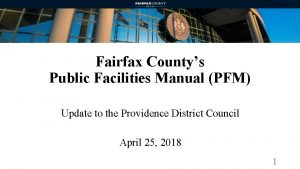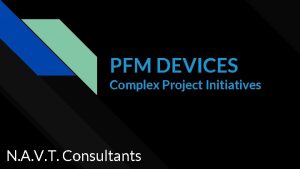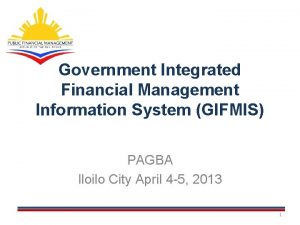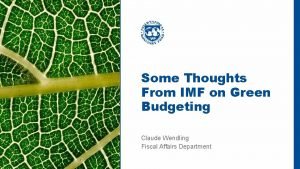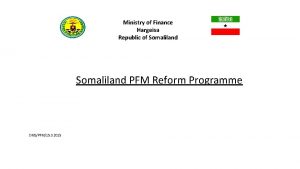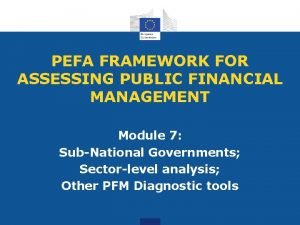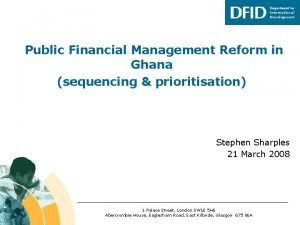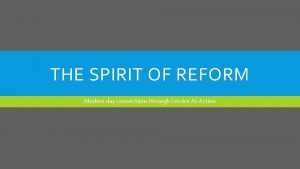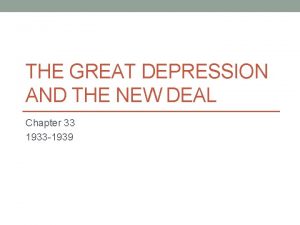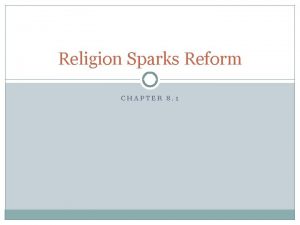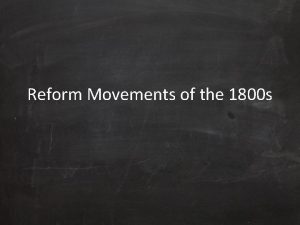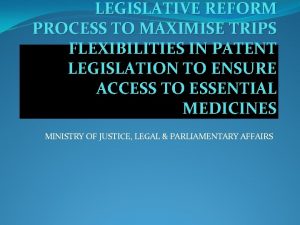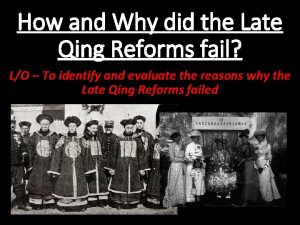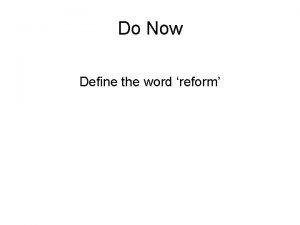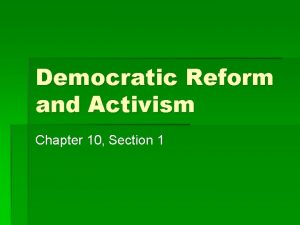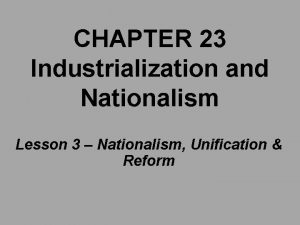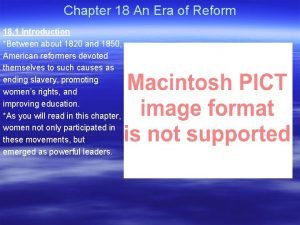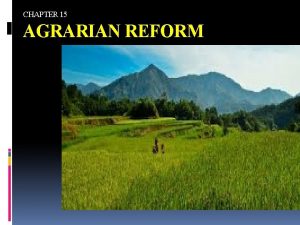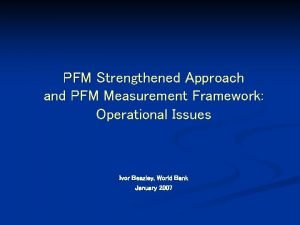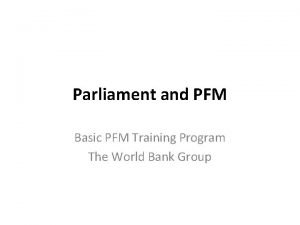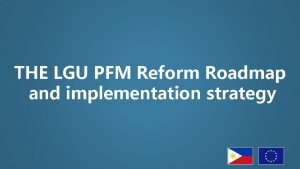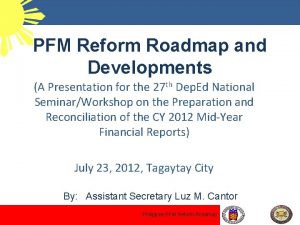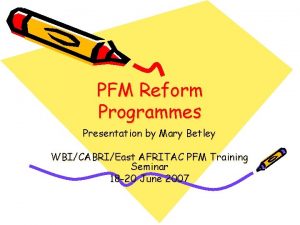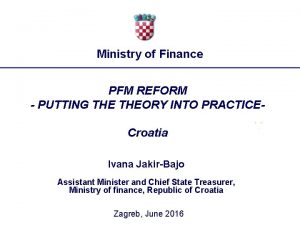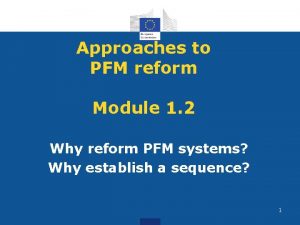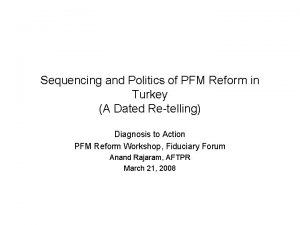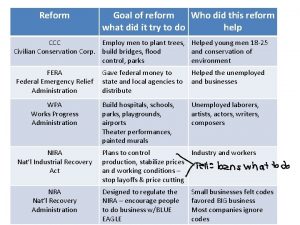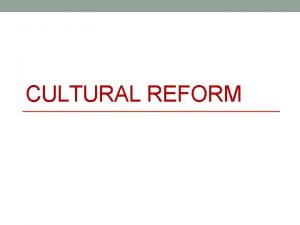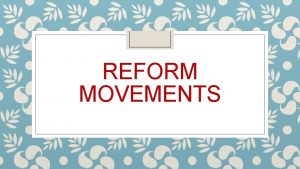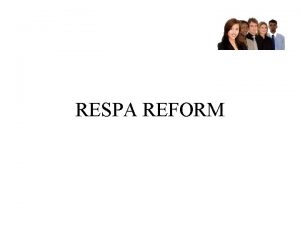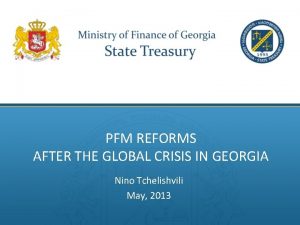PFM II PFM Reform INTRODUCTION 1 PFM Reform





























- Slides: 29

PFM II PFM Reform INTRODUCTION 1

PFM Reform: Course Objectives • To provide tools for understanding, analyzing and sequencing budgetary reform • To introduce the importance of and rationale for sequencing and scheduling PFM reforms • The material is focused on the instruments and processes to manage reform, and not on public policy itself • The debate is centered around the public finance management at the level of the cenral administration 2

Course outline • Day 1: Approaches to PFM reform • Day 2 : PFM sub-systems and prioritization amongst them • Day 3: Change management – Reform sequencing issues – Case study 3

Day 1: Approaches to PFM Reform • Module 1. 1. PFM objectives and budgetary approaches • Module 1. 2. Why reform PFM systems? Why sequencing? • Module 1. 3. The starting point: assessing PFM systems • Module 1. 4. Conditions for successful reform 4

Approaches to PFM reform Module 1. 1 PFM objectives and budgetary approaches 5

Module 1. 1: Objectives • Fiscal reforms aim at enhancing systems of PFM according to their objectives. • In this module, after a brief reminder of the definition of PFM, will look at the objectives of PFM and the broad guidelines to budgetary approaches 6

Module 1. 1. Outline • What is PFM ? • Objectives of PFM • Budgetary approaches and provision of public services • Hierarchy amongst PFM objectives 7

Public Finance Management (PFM) OECD DAC 2009 Definition of PFM: “PFM includes all components of a national budget process… including strategic planning, mediumterm expenditure framework, annual budgeting, as well as revenue management, procurement, controlling, accounting, reporting, monitoring and assessing, audit and external supervision. “ 8

PFM encompasses all public administrations • Public administrations include: • Central government • State government in federal countries • Local government • Social security funds, that are sometimes considered as a separate sub-sector • Public sector also includes corporations and quasicorporations controlled by the government units 9

Administrations encompassed in PFM 10 Source: Government Finance Statistics (GFS). IMF

The purpose of Public Finance Management • PFM is an instrument used to implement public policies. o Public policies: e. g. growth, poverty reduction, macroeconomic stability, etc. o Instruments for implementing public policies: PFM, regulation, public corporations • PFM must, as much as possible, be in line with the objectives of public policies. • As an instrument, PFM is in part independent from public policies’ objectives, but only in part o Approaches that are adopted regarding PFM are in part influenced by societal choices and public policy objectives 11

Module 1. 1. Outline • What is PFM ? • Objectives of PFM • Budgetary approaches and provision of public services • Hierarchy amongst PFM objectives 12

Approaches to PFM “Traditional” approach • Focused on integrity, consistency, ethics of public service • Pre-eminence is given to respecting procedures, & to implementing performance tests in budget management “Modern” approach: focuses on: • formulation & planning of public policies • performance in conduct of activities 13

The objectives of PFM ’Traditional’ approach: financial compliance (budget discipline) /compliance to the law Three objectives of ‘modern’ approach 1. Aggregate fiscal discipline 2. Strategic allocation of resources in compliance with public policy objectives 3. Efficient delivery of public services 14

The concept of performance Effectiveness (fulfil objectives) & efficiency (be productive) – take into account quality Process of public service provision & aspects of performance 15

The societal dimension • Aids in achievement of PFM objectives, but also represents societal values • Accountability/ Responsibility / Liability: two aspects: reporting & ensuring accountability to Parliament & citizens • Being receptive • Promoting democratic values • Transparency (IMF Manual on Fiscal Transparency) • Precision concerning roles & responsibilities • Unrestricted public access to information • Transparency in preparation & implementation of the budget, as well as all related information • Independent safeguard of integrity 16

Relations between the different objectives and dimensions (1) Essential to take into account risks of complementarity & conflict between objectives & dimensions Complementarity, examples: o Being accountable to Parliament strengthens control o Without fiscal discipline, provision of public goods may be wasteful Conflict, examples: o More flexible management may improve performance, but alter control system o Increasing power of Parliament may affect overall budgetary discipline o Poorly designed measures to improve financial discipline may have negative effects on performance 17

Relations between objectives and dimensions (2) • Care should be taken to find optimal set of measures that will enable moving towards one or more objectives, without moving away from another • Optimal composition of a set of objectives depends on the context of each country 18

Avoiding schematisation • The depth & method of taking into account interdependencies between objectives & societal dimensions generally leads to consideration of various methods of achieving these objectives • For example, while setting an objective of ‘financial discipline’, emphasis may be on: o ‘hard’ control or on transparency of controls & absence of any arbitrariness o Compliance with budgetary authorizations, whether initial or revised, or on sole compliance with initial budgetary compliance, given that budget revisions are of small scale (credibility of budget as per PEFA) 19

Module 1. 1. Outline • What is PFM ? • Objectives of PFM • Budgetary approaches and provision of public services • Hierarchy amongst PFM objectives 20

Budgetary approaches 1. ‘Traditional’ budgeting: focused on inputs & means • Strengths • Ensuring basic processes • Building a culture of discipline • Weaknesses • As a general rule, little consideration is given to public policies and their results • Often, heavy bureaucratic processes 21

Budgetary approaches: result-oriented 2. ‘Result-oriented’ Budgeting: focus on output /effectiveness &/or outcome/efficiency • Strengths: • Reflect the actual objective of budgeting • Weaknesses: • Require solid institutional frameworks • Effectiveness depends on country context 22

Budgetary approaches ‘Traditional’ Aims at saving money ‘ROM’, ‘programme/performance budget’ Aims to achieve performance 23

Module 1. 1. Outline • What is PFM ? • Objectives of PFM • Budgetary approaches and provision of public services • Hierarchy amongst PFM objectives 24

Hierarchy amongst PFM objectives (1) Objectives of PFM are interdependent, but: • Maintaining an adequate level of fiscal discipline (probity, consistency) is a necessary condition to safeguarding other objectives • Without fiscal discipline, there is no accounting/accountability, public policy choices may not be respected and there is no efficiency • Without overall budgetary discipline it does not make sense to prioritize, and provision of public services is disorganized (e. g. Generation of arrears) 25

Hierarchy amongst PFM objectives The following hierarchy can be defined: • First: Budgetary discipline • Then: Aggregate fiscal discipline • Then: other objectives, • 2. strategic allocation of resources; • 3. Efficient provision of public services Is there a hierarchy between objectives 2 & 3? 26

Hierarchy amongst PFM objectives and budgetary approach The note on ‘Best practices on sequencing of reforms’ links objectives of PFM to budgetary approaches • Budget Discipline: traditional budget • Aggregate Fiscal Discipline: Traditional budget with an emphasis on macro-economic control • Efficiency & Effectiveness: emphasis on results • The Note uses the term efficiency rather than strategic allocation of resources to avoid mixing up political & managerial dimension of resource allocation 27

Frameworks for looking at PFM Good Practice Note on Sequencing PFM Reforms, , Jack Diamond 2012 28

Key messages • This module identified the main objectives of PFM: Budgetary discipline, aggregate fiscal discipline, strategic allocation of resources, efficient provision of public services. • Improving the performance of a budgetary system aims at enabling a greater fulfilment of its objectives • Satisfactory fiscal discipline is a necessary condition for achieving its other objectives 29
 Fairfax county public facilities manual
Fairfax county public facilities manual Pfm devices
Pfm devices Gifmis
Gifmis Pfm roofing
Pfm roofing Somaliland pfm
Somaliland pfm Pfm asset management
Pfm asset management Pfm somaliland learning
Pfm somaliland learning Diagnostic tools for pfm
Diagnostic tools for pfm Pufmarp
Pufmarp The spirit of reform lesson 1
The spirit of reform lesson 1 Was the tva a relief recovery reform
Was the tva a relief recovery reform Religion sparks reform chapter 8
Religion sparks reform chapter 8 When was the education reform movement
When was the education reform movement Reform movements 1800s
Reform movements 1800s 10.sınıf tarih reform hareketleri
10.sınıf tarih reform hareketleri Law reform process
Law reform process Land reform definition
Land reform definition Land tenure reform law
Land tenure reform law Late qing reform
Late qing reform Was the tva a relief recovery reform
Was the tva a relief recovery reform Grade 12 settlement geography question papers
Grade 12 settlement geography question papers Define the word reform
Define the word reform Democratic reform and activism
Democratic reform and activism Chapter 10 section 1 democratic reform and activism
Chapter 10 section 1 democratic reform and activism Religion sparks reform chapter 8
Religion sparks reform chapter 8 Chapter 23 lesson 3 nationalism unification and reform
Chapter 23 lesson 3 nationalism unification and reform An era of reform answers
An era of reform answers An era of reform chapter 18 answer key
An era of reform chapter 18 answer key The ferment of reform and culture
The ferment of reform and culture Adopted bayan-anihan
Adopted bayan-anihan
